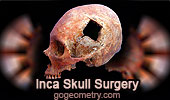Inca Skull Surgeons Were "Highly Skilled," Study Finds
National Geographic by News Scott Norris.
Inca surgeons in ancient Peru commonly and successfully removed small portions of patients' skulls to treat head injuries, according to a new study.
The surgical procedure—known as trepanation—was most often performed on adult men, likely to treat injuries suffered during combat, researchers say.
A similar procedure is performed today to relieve pressure caused by fluid buildup following severe head trauma.
Around the ancient Inca capital of Cuzco (see Peru map), remains dating back to A.D. 1000 show that surgical techniques were standardized and perfected over time, according to the report.
Many of the oldest skulls showed no evidence of bone healing following the operation, suggesting that the procedure was probably fatal.
But by the 1400s, survival rates approached 90 percent, and infection levels were very low, researchers say.
The new findings show that Inca surgeons had developed a detailed knowledge of cranial anatomy, said lead author Valerie Andrushko, of Southern Connecticut State University in New Haven.
"These people were skilled surgeons," she said.
Beer, Plants Aided Patients
Inca healers carefully avoided areas of the skull where cutting would be more likely to cause brain injury, bleeding, or infection, Andrushko noted.
The operations were conducted without the modern benefits of anesthesia and antibiotics, but medicinal plants were probably used, she said.
"They were aware of the medicinal properties of many wild plants, including coca and wild tobacco," Andrushko said.
"These, along with maize beer, may have been used to alleviate some of the pain.
"Natural antiseptics such as balsam and saponins [plants with soaplike properties] may have reduced the likelihood of infection following trepanation," she added.
The new study was recently published online in The American Journal of Physical Anthropology.
"Skull Was Slowly Scraped Away"
Andrushko and study co-author John Verano of Tulane University in New Orleans studied remains from 11 burial sites in Cuzco and the surrounding region.
Their survey found that trepanation was a remarkably common practice in the Inca capital. Of 411 skulls that were sufficiently well preserved to study, 66 had holes cut through the bone.
In one location, 21 of 59 skulls—over a third—had received trepanation.
While methods of trepanation varied over time, Inca surgeons eventually settled on a scraping technique to penetrate the skull without causing wider injury.
"The skull was slowly scraped away, resulting in a circular hole surrounded by a wider area of scraped bone," Andrushko said.
Some of the skulls had been perforated more than once, including one individual who had undergone the operation seven times.
In another unusual case, in which the patient did not survive the operation, a rectangular section of bone that had been removed was set back in place prior to burial.
Tiffiny Tung is an archaeologist at Vanderbilt University in Nashville, Tennessee, and was not part of the research.
She said that the new study is the first to compare the frequency and success rate of trepanation over time and in different communities.
"This is the kind of richly detailed study that really gives us a sense of what life was like for ancient Andean populations," Tung said.
"It's astounding that [such a large percentage] of the population underwent skull surgery and that so many survived."
Read More
Incan skull surgery
April 25, 2008.
Source:
Sciences News by Bruce Bower
Holes in ancient skulls reflect skilled medical care
When Incan healers scraped or cut a hunk of bone out of a person’s head, they meant business. Practitioners of this technique, known as trepanation, demonstrated great skill more than 500 years ago in treating warriors’ head wounds and possibly other medical problems, rarely causing infections or killing their patients, two anthropologists find.
Trepanation emerged as a promising but dangerous medical procedure by about 1,000 years ago in small communities near the eventual Inca heartland in Peru’s Andes mountains, say Valerie Andrushko of Southern Connecticut State University in New Haven and John Verano
of Tulane University in New Orleans. Incan healers later
mastered certain trepanation methods, performing them
safely and frequently.
Read More

Home |
Incas |
Inca Surgery |
Email | by Antonio Gutierrez
Last updated: May 21, 2009
|